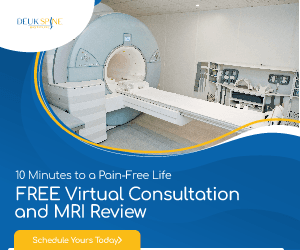
Neck pain is more common than ever, and a big part of the problem is something surprisingly simple: posture. From long hours at the computer to constantly looking down at your phone, the way you position your head and neck affects the entire cervical spine. Even small changes in alignment can create major strain and eventually lead to pain, stiffness, headaches, or nerve symptoms.
The Checklist: A Simple Self-Assessment for Cervical Alignment
You don't need a medical degree to spot the warning signs of poor posture. By running through this 4-point checklist at home, you can identify potential stress points.

[ ] The "Plumb Line" Alignment Check
This step checks your forward head posture. You will need a mirror or a family member to help you look.
- The setup: Stand sideways next to a mirror in your natural, relaxed posture. Do not force yourself to stand up straighter than usual; you want to see your normal posture.
- The check: Imagine a vertical line dropping from the ceiling. In a healthy spine, this line should pass through your earlobe and land directly in the center of your shoulder.
- The result: If your earlobe is positioned in front of your shoulder, your head is anteriorly shifted. For every inch your ear is forward of your shoulder, the mechanical load on your neck muscles doubles or triples.
[ ] Palpation Test (Touch Assessment)
"Palpation" means checking the body by touch. You are looking for tenderness, which indicates inflammation or muscle fatigue.
- Base of the skull: Press your thumbs into the soft area right where your skull meets your neck. Tenderness here often indicates "suboccipital muscle" tightness, a common cause of tension headaches.
- The "bony bumps" (spinous processes): Run your fingers gently down the center of the back of your neck. You will feel small bony ridges. These should feel aligned. If pressing on one causes a sharp pain or a "zing" of electricity, it may indicate a vertebral issue or irritation.
- The upper traps: Squeeze the large muscle between your neck and your shoulder. If this feels rock-hard or painful to the touch, your shoulders are likely hiking up toward your ears due to stress or poor desk ergonomics.
[ ] Side-Profile Photo Analysis
Sometimes it is hard to be objective in a mirror. Have someone take a photo of you from the side (profile view) while you are looking at your phone or sitting at your computer. Look for these three distinct shapes:
- The c-shape: Does your upper back round forward excessively (kyphosis)?
- The turtle: Is your chin jutting forward while your head tilts back?
- The slump: Are your shoulders rolled forward, closing off your chest?
[ ] Symptom Inventory
Your body usually whispers before it screams. Ask yourself if you experience these specific warning signs:
- [ ] Do I feel a burning tightness at the base of the neck after 30 minutes at a computer?
- [ ] Do I wake up with headaches that start at the back of the skull and radiate to the eyes?
- [ ] Does my neck make grinding or "sandpaper" noises (crepitus) when I turn my head?
- [ ] Do I ever feel tingling, numbness, or a "falling asleep" sensation in my fingers?
- Note: If you checked the last box, this is a strong sign of nerve compression or cervical radiculopathy.
Restoring Balance: Exercises to Reduce Stress on the Cervical Spine
If your assessment revealed forward head posture or rounded shoulders, simply "sitting up straight" might not be enough. Your muscles may need retraining to hold the weight of the head correctly. The following movements are designed to engage the neglected stabilizers of the neck and open up tight chest muscles.

1. Chin Tucks (Retraction)
Goal: Reversing forward head posture and lengthening the back of the neck. How to do it correctly:
- Sit or stand with your spine tall.
- Look straight ahead (do not look down).
- Draw your head straight back as if you are trying to make a "double chin" or sliding your head back on a shelf.
- You should feel a gentle pull at the very base of your skull.
- Hold for 5 seconds, release, and repeat 10 to 15 times.
2. Scapular Retractions (Shoulder Squeezes)
Goal: Counteracting the "slump" or c-shape by strengthening the rhomboids and middle trapezius. How to do it correctly:
- Relax your arms by your sides.
- Imagine there is a pencil positioned vertically between your shoulder blades.
- Squeeze your shoulder blades back and down (not up toward your ears) to pinch that imaginary pencil.
- Hold the squeeze for 5 seconds. Repeat 10 to 20 times.
3. Levator Scapulae Release
Goal: Loosening the muscle that connects the neck to the shoulder blade, which is often responsible for stiff necks. How to do it correctly:
- Sit on a chair and grab the bottom of the seat with your right hand (this anchors the shoulder down).
- Turn your nose 45 degrees to the left (toward your left armpit).
- Use your left hand to gently pull your head down, as if trying to smell your armpit.
- Hold for 20 to 30 seconds while breathing deeply. Switch sides.
4. Doorway Chest Stretch
Goal: Relaxing the pectoralis muscles. When these are tight, they pull the shoulders forward, forcing the neck out of alignment. How to do it correctly:
- Stand in an open doorway.
- Place your forearm on the doorframe at a 90-degree angle (elbow at shoulder height).
- Step one foot through the doorway and gently lean your body weight forward until you feel a stretch across the front of your chest and shoulder.
- Do not let your back arch. Hold for 20–30 seconds.
5. Supine Deep Neck Flexor Activation
Goal: Releasing the "core" muscles of the neck (longus colli) that stabilize the spine. How to do it correctly:
- Lie flat on your back (no pillow) with knees bent.
- Perform a chin tuck (make a double chin) while keeping the back of your head in contact with the floor.
- Hold this "tucked" position for 5–10 seconds. You should feel the muscles deep in the front of your throat working, not the large superficial muscles on the side.
- Repeat 10–15 times.
Tried everything and still experiencing pain? Get the answers you need now.

Why This Matters: The Physics of Poor Posture
Your cervical spine is an engineering marvel designed to hold your head in a balanced, neutral position. In that state, the head weighs roughly 10 to 12 pounds.
However, when posture slips, the physics change. Weaknesses or malformations can increase the risk of serious injury in the event of an accident or other event. For every one inch your head moves forward, the leverage adds roughly 10 to 15 pounds of extra pressure on the spine.
This massive increase in weight affects:
- Cervical discs: Leading to uneven wear and tear.
- Facet joints: Causing inflammation and arthritis.
- Nerves: Compressing the pathways traveling from the neck into the arms.
Over time, these unchecked stressors can lead to:
- Herniated cervical discs
- Cervical radiculopathy
- Spinal stenosis
- Degenerative disc disease
- Chronic headaches or migraines
When Posture Correction Isn’t Enough
Exercise and posture changes can ease neck pain for many people, especially when the underlying issue is muscular. But when structural problems—like herniated discs, bone spurs, or significant nerve compression—are present, conservative care may only provide limited relief. These types of changes alter the anatomy of the cervical spine, and symptoms often persist until the damaged disc or joint is directly treated.
At the Deuk Spine Institute, we focus on treating the root causes of chronic neck pain using advanced, minimally invasive techniques. For disc-related pain, we use the Deuk Laser Disc Repair (DLDR)®, a procedure that removes the damaged portion of the disc through a small incision at the front of the neck. A precision laser is used to clear the herniation pressing on nerves—without the need for metal implants, screws, or spinal fusion.
Benefits of Deuk Laser Disc Repair (DLDR):
- Minimally invasive 4 mm incision
- No metal hardware
- No joint fusion
- Outpatient procedure with same-day return home
- Faster recovery compared to traditional open surgeries
- No need for post-operative narcotics
- 99.6% success rate in eliminating discogenic neck pain
For pain coming from the facet joints, we offer the Deuk Plasma Rhizotomy (DPR)®. This minimally invasive treatment targets irritated facet nerves without implants, hardware, or narcotics, and is performed on an outpatient basis.
Benefits of Deuk Plasma Rhizotomy (DPR):
- Minimally invasive approach
- No metal or hardware
- No post-operative narcotics
- Outpatient procedure with rapid recovery
These procedures provide effective alternatives to more invasive surgeries, such as fusions or laminectomies, that often require a longer recovery and have lower long-term success rates. DLDR and DPR focus on preserving natural motion while directly addressing the source of pain, offering patients a reliable path toward lasting relief.
Get a Free MRI Review and Consultation from Deuk Spine Institute
Getting answers shouldn’t be complicated. If you already have a cervical MRI, send it to Deuk Spine Institute to learn:
- What is causing your pain
- Whether your condition can be treated without fusion
- If you’re a candidate for Deuk Laser Disc Repair
Why patients choose Deuk Spine Institute:
- Thousands of successful laser spine procedures.
- Zero surgical infections.
- One of the top minimally invasive spine surgeons in the world.
- Trusted by patients across the U.S. and internationally.
If you're ready to stop living with neck pain, start with answers and a personalized plan. See what our patients are saying.
Patient Story
Make Your First Pain-Free Move
If you’re seeking relief from lumbar pain, have been recommended for a TLIF spinal fusion, or are still dealing with chronic neck pain after a failed fusion surgery, we can help improve your quality of life and enable you to live pain-free.
Upload your latest MRI for a free review and a personal consultation with myself. Ara Deukmedjian, M.D., founder of Deuk Spine Institute and creator of the Deuk Laser Disc Repair® procedure.
FAQs
- How does posture affect the cervical spine? Poor posture, especially forward head posture, increases the gravitational pull on the skull, dramatically increasing the weight supported by the cervical discs and muscles. Over time, this pressure leads to disc herniation and degeneration.
- What is forward head posture, and why is it harmful? Forward head posture occurs when the head sits ahead of the shoulders rather than directly above them. It is harmful because it strains the posterior neck muscles and compresses the anterior cervical discs, often leading to nerve impingement.
- How can I check my neck alignment at home? Use the "plumb line" test: Stand sideways at a mirror. If your ear lobe is positioned forward of your shoulder center, your alignment is off. You can also palpate for tenderness at the base of the skull and check for rounded shoulders. Find more details on these exercises above.
- What exercises help strengthen deep neck flexors? The chin tuck is the gold standard. Lie on your back with knees bent, tuck your chin gently toward your throat (creating a double chin) without lifting your head off the floor. Hold for 5–10 seconds.
- When should I consider a Free MRI Review at Deuk Spine Institute? If you have persistent neck pain, numbness, tingling in the hands, or have been told you need surgery, a free MRI review can identify the exact cause and determine if minimally invasive Deuk Laser Disc Repair is an option for you.

